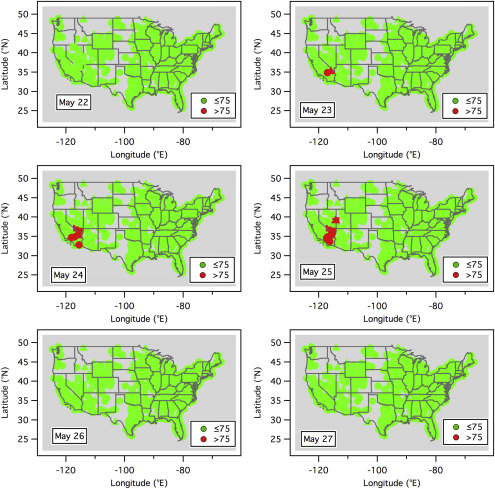A .gov website belongs to an official government organization in the United States.
A lock () or https:// means you've safely connected to the .gov website. Share sensitive information only on official, secure websites.
10 February 2018

Recent research published in Atmospheric Environment used various measurement techniques to assess stratospheric intrusions and their impact on surface ozone and air quality, and shows the benefit of using both surface-measurements and upper air observations to better understand the sources of ozone.
Ozone is a secondary pollutant that is detrimental to human health, and crop and ecosystem productivity. To protect public health, the U.S. Environmental Protection Agency established the National Ambient Air Quality Standards (NAAQS). However, areas in the Western United States exceed these standards on occasion. One such example occurred 24-25 May 2013, when ozone concentrations in California and Nevada exceeded the 70 parts-per-billion (ppb) prescribed by the NAAQS for the daily maximum 8-hour average.
There are many sources of ozone in the atmosphere, including sunlight-driven reactions between human-produced precursors (e.g., nitrogen oxides and volatile organic compounds) that can potentially be reduced through control strategies. However, there are other sources of ozone that can't be controlled, including wildfire emissions, transport of ozone from other areas, and from the upper atmosphere. Stratospheric intrusions occur when naturally occurring ozone is transported downward from the stratosphere into the lower troposphere. This descending stratospheric air can also bring with it additional man-made ozone that has been transported across the Pacific Ocean from Asia. These stratospheric intrusion events can create localized spikes in surface ozone and increase background concentrations over large areas for several days. Previous research by lead author Andy Langford and colleagues has shown stratospheric intrusions to be an important factor on some days when ozone levels exceed the NAAQS standard in the western U.S.
Andy Langford and other scientists from CSD combined a variety of measurement techniques to study stratospheric intrusions on May 24-25, 2013. They used ground-based lidars and ozonesondes with the NASA Tropospheric Ozone Lidar Network (TOLNet) in California, Nevada, and Alabama, and aircraft measurements from the NASA Alpha Jet Atmospheric eXperiment (AJAX) in California. They compared these measurements to data from the satellite-borne NASA Atmospheric Infrared Sounder (AIRS) and to several models.
An important conclusion of this research is that the descent of ozone-rich air from higher in the atmosphere down into the lower troposphere has a much greater impact on surface air-quality in the Southwest than the Southeast. These data suggest that these stratospheric intrusions contributed to exceedances of the NAAQS that were seen in Southern California and Nevada in May of 2013.
Langford, A.O., R.J. Alvarez II, J. Brioude, S. Evan, L.T. Iraci, G. Kirgis, S. Kuang, T. Leblanc, M.J. Newchurch, R.B. Pierce, C.J. Senff, and E.L. Yates, Coordinated profiling of stratospheric intrusions and transported pollution by the Tropospheric Ozone Lidar Network (TOLNet) and NASA Alpha Jet experiment (AJAX): Observations and comparison to HYSPLIT, RAQMS, and FLEXPART, Atmospheric Environment, doi:10.1016/j.atmosenv.2017.11.031, 2018.
Ground-based lidars and ozonesondes belonging to the NASA-supported Tropospheric Ozone Lidar Network (TOLNet) are used in conjunction with the NASA Alpha Jet Atmospheric eXperiment (AJAX) to investigate the transport of stratospheric ozone and entrained pollution into the lower troposphere above the United States on May 24-25, 2013. TOLNet and AJAX measurements made in California, Nevada, and Alabama are compared to tropospheric ozone retrievals from the Atmospheric Infrared Sounder (AIRS), to back trajectories from the NOAA Air Resources Laboratory (ARL) Hybrid Single Particle Lagrangian Integrated Trajectory (HYSPLIT) model, and to analyses from the NOAA/NESDIS Real-time Air Quality Modeling System (RAQMS) and FLEXPART particle dispersion model. The measurements and model analyses show much deeper descent of ozone-rich upper tropospheric/lower stratospheric air above the Desert Southwest than above the Southeast, and comparisons to surface measurements from regulatory monitors reporting to the U.S. EPA Air Quality System (AQS) suggest that there was a much greater surface impact in the Southwest including exceedances of the 2008 National Ambient Air Quality Standard (NAAQS) of 0.075 ppm in both Southern California and Nevada. Our analysis demonstrates the potential benefits to be gained by supplementing the existing surface ozone network with coordinated upper air observations by TOLNet.